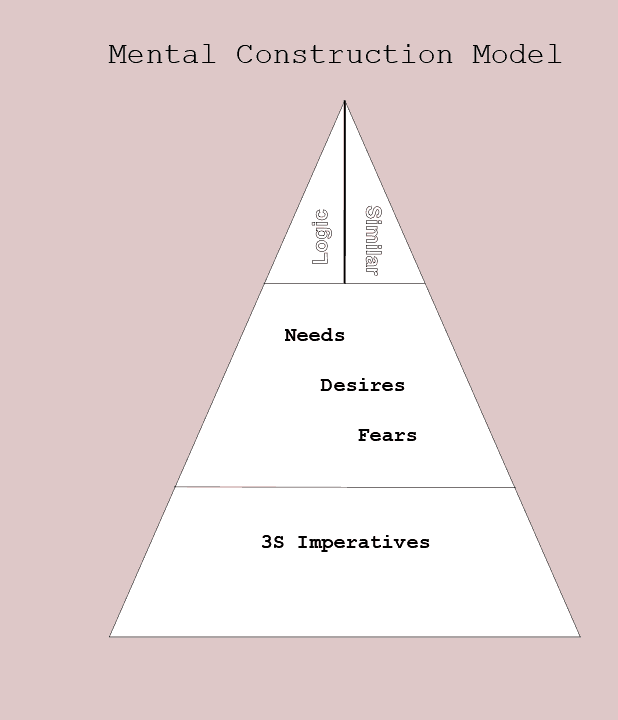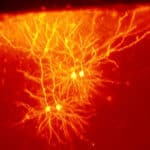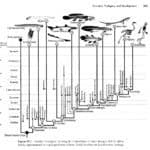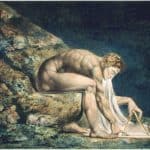
Mental Construction (MC) explains how we think, based on properties of neurons which comprise the mind. Starting with the neural threshold, it develops the abstraction and categorization which lead to association and induction. Figure 1.1 creatively shows the veil that our neural brain imposes between the external world and our internalization of the world.
These page introduces ideas which bridge the explanatory gap between neuroscience and cognitive psychology. Combining the neuron’s All-or-None electronic threshold and Hebb’s Law—neurons that fire together, wire together—a systematic organization of thoughts arises. Raw data is abstracted. From that commonality, associations naturally link together thoughts and memories in connected strands.
Is there a sensible relationship between the All-or-None neural process and thoughts that are associated? Mental Construction develops the affirmative answer and many consequences—abstraction, categorization, partial-matching, and associative linkages.
Mental Construction focuses on highlighting the importance of association and induction. The importance of logic is not denied by Mental Construction. Deduction and logic are taken as given. They contribute greatly to our thoughts and behavior. MC explains how association interacts with logic and how abstraction supplies premises for deduction, uniting to support overall cognition.
Thinking. Eternal Questions
Some questions that motivate this investigation into cognition.
- How do we conceive a stable reality when reality changes every instance?
- How do we have a complete view of reality when we only see a part of reality?
- Are there innate ideas we are born with? Surely experience is not everything. What is the mixture and how are nature and nurture combined?
- Do you pride yourself as always logical? Or perhaps you follow your hunches, no matter the logical arguments made against them?
- What role do emotions have in thoughts?
Most people accept that logical, verbal thinking occurs and already have theories about that. It is the intuitive, common sense, hunches, leaps of faith, and creative imagination which are shrouded in mystery. This site ties the non-logical to their neurological origin.
Mental Construction Model
The Mental Construction Model of cognition—brain activity that occurs before consciousness and with consciousness—has many aspects. The pyramidal shape of cognition in Figure 1.2 summarizes complex processes.
- The base layer of 3S Imperatives (Satiety, Sex, and Safety) underlie all the processing that goes on in our head. Biological demands flavor the entirety of our thoughts.
- The middle layer of needs, desires, and fears are folk psychology terms. They reflect the limited satisfaction that personal experience delivered on our demands for our bodily organism, sexual impulses, and personal safety.
- The capstone of cognition has two separate components—logic and associations by similarity. These two mechanisms receive the results of the lower layers of the cognition pyramid. If an immediate response is called for, associations by similarity is readily available, while logic with verbal analysis require time, although can often provide a superior answer.
The neural threshold with its All-or-None output results in the Almost Gate function. Any set of inputs that are almost the same will be treated as identical. When sensory input is processed, detail beyond the possible categories is lost. A simplification, an abstraction occurs.
Of course, in one step, the loss of detail is slight, but there is not a single Almost Gate separating external reality from internal worldview. A rule of thumb, the 100-Step Rule, estimates 100 neural exchanges are crossed from sensory receipt to our first reaction to it. Thus about 50 neural exchanges to arrive at our conscious awareness and 50 more on the way out to an observable response. This neural cascade of 50 steps results in a loss detail and an increase in abstraction at each threshold.
All ideas are inherently abstracted as they shuttle though our neural brain. When two abstracted ideas both exceed the Almost Gate, the downstream neurons see both ideas as the same. If the downstream result has been useful for one idea before, the other one will be creatively linked to it. This is not a logical link, but an associated link.
Particular Details
- Neural threshold and All-or-None excitation leads to the Almost Gate
- Neural Cascade, the 100-Step rule, and implications about certainty
- Cognitive associations are a source of our thoughts
- Creativity arises from slighter associations that prove useful
Background
- Mindset. Exterior reality to internal worldview Although external reality is clearly different than our internal view of it, so much so that classical philosophers like Descartes and Berkeley considered them of separate existences, our senses deliver the outside world to the brain stem and cortical lobes where we incorporate that information with previous experiences and build our internal mindset.
- Maps in the brain Sensory patterns when repeatedly experience are automatically grouped by common features, so are semantic patterns.
- Brain building Biological necessity precedes cortical lobes. Accumulated knowledge is learned over many years
- Cognition Roles of induction and deduction
I am a generalist, not a specialist in neuroscience and cognitive psychology (see Author’s Page). Mental Construction focuses on association, similarity, and abstraction, how they arise and the impact they have. I am presenting results only in the detail necessary to make the argument. The Brain from Top to Bottom hosted by McGill University is a solid, well-organized resource. Since words are but one way to organize ideas, Mental Construction presents many diagrams to visually make points for those of us who don’t think primarily in words.
Ordered Explanation
The Table of Contents presents the points in a sequential order. It is always available in the navigation bar at the page top.
- First, we examine the physiological-to-psychological path that sensory input takes on its way to becoming our internal view of the world.
- Then, we’ll look into the brain’s cortex and the neural features that underlies our pattern-matching (association processing) that supports the psychological insights of association, categorization, and mapping.
- After that, I will present the highlights in the brain development, from the earliest animals to humans and from baby to adult, which will contribute to the understanding of our behaviors and thoughts.
- Our cognition (thinking, both conscious and preconsious) is discussed from source of thought to concept elevation, the neural probability cascade, and the intertwined relationship of association and logic.
- Next, association’s role in long-standing mystery of the source of creativity.
- Mental Construction closes with its process of induction and deduction working together.
This site has two main sections—a book and posts. The Table of Contents item on the navigation menu leads to an organized collection of essays developing the main ideas of Mental Construction. The posts chronologically displayed on the home page explore further implications with links back to the book supporting specific points.
Sensory data from external to internal, with emotional weigh and more
Neural connections lead to Almost Gates; with Hebb’s Law, mental maps
Brain Building New behavior starts with existing behavior and enhances that
Understanding thinking has absorbed attention since antiquity
Creativity Divine inspiration. Working Together





